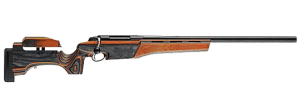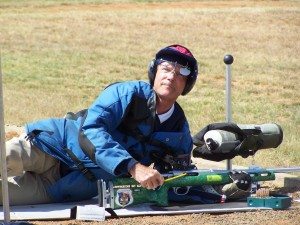Shooting 1000 Yards with a .223? Yes, actually we recently got a hit at 1,385 yards!

Here at the Jackson Hole Shooting Experience, we have a Tikka M595 chambered in .223 Remington. As many of our clients enjoy mid & long range precision shooting, I recently became interested in Shooting 1000 Yards with a .223 with our Tikka, which has a 1 in 12 twist. Competitive shooter Mark Frisbee, who has great success with his .223 at 1,000 yard matches, thought a 1 in 8 twist was probably necessary, but suggested I ask our mutual mentor for a decisive answer.
So, I asked world class shooter and external ballistics expert David Crandall, fresh off his summer 2015 Gold Medal “Veterans Team Match” win at the 2015 World Championship of Long Range Rifle Shooting, about this possibility. David Crandall is among the top ballistics experts in the world, and retired from his long career as an engineer developing small arms systems for the gummint, so I knew I would hear more than I could understand, but I decided to ask.

My question to David was, “My Tikka has a 1 in 12 twist (the lands and grooves rotate a full 360 degrees every 12 inches), is there a factory ammunition that I can buy that would allow me to consistently get hits on target at 1,000 yards?”
I figured we could all learn from David’s reply, which turned out to be very understandable, even to a layman like me. As it turns out:
The short answer is no.
A longer answer:
Rifle bullets do not normally want to fly point forward. If they start out point forward the air drag on the nose wants to tip them sideways. We overcome this by spinning them using the rifling. For any given caliber and bullet, there is a minimum spin rate needed to keep it point forward, short bullets in large calibers require less spin, long bullets in smaller calibers require more spin. A 1-12 twist is sufficient only for .224 bullets of less than 60 grains and then only at supersonic speeds.
The stability of bullets is also influenced by the range of velocities it must fly through. The stability requirements at velocities above the speed of sound are less than they are right around the speed of sound. Special bullet shapes are required near the speed of sound because of the shock wave induced turbulence. These high stability shapes are typically not the best for maintaining high velocity. When shooting at longer ranges such as 1000 yards, we use long streamlined bullets with high ballistic coefficients. These long streamlined bullets destabilize and tumble when they slow down to near the speed of sound so it is important to keep them supersonic. It is also important to spin them using twist rates like 1-8 to keep them from tumbling.
The bottom line:
Any bullet short enough to stabilize in 1-12 .223 caliber rifle will not have the ballistic capability to remain supersonic over 1000 yard and so will destabilize and tumble destroying accuracy. These lighter bullet may shoot very well at shorter ranges but seldom strike targets at ranges of 600 yards and beyond, and when they do, they are usually flying sideways.
Sincerely,
David Crandall
